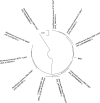Exploring Andean High-Altitude Lake Extremophiles through Advanced Proteotyping
- PMID: 38377575
- PMCID: PMC10913102
- DOI: 10.1021/acs.jproteome.3c00538
Exploring Andean High-Altitude Lake Extremophiles through Advanced Proteotyping
Abstract
Quickly identifying and characterizing isolates from extreme environments is currently challenging while very important to explore the Earth's biodiversity. As these isolates may, in principle, be distantly related to known species, techniques are needed to reliably identify the branch of life to which they belong. Proteotyping these environmental isolates by tandem mass spectrometry offers a rapid and cost-effective option for their identification using their peptide profiles. In this study, we document the first high-throughput proteotyping approach for environmental extremophilic and halophilic isolates. Microorganisms were isolated from samples originating from high-altitude Andean lakes (3700-4300 m a.s.l.) in the Chilean Altiplano, which represent environments on Earth that resemble conditions on other planets. A total of 66 microorganisms were cultivated and identified by proteotyping and 16S rRNA gene amplicon sequencing. Both the approaches revealed the same genus identification for all isolates except for three isolates possibly representing not yet taxonomically characterized organisms based on their peptidomes. Proteotyping was able to indicate the presence of two potentially new genera from the families of Paracoccaceae and Chromatiaceae/Alteromonadaceae, which have been overlooked by 16S rRNA amplicon sequencing approach only. The paper highlights that proteotyping has the potential to discover undescribed microorganisms from extreme environments.
Keywords: Altiplano; Atacama Desert; extremophiles; halophiles; high-altitude Andean lakes; tandem mass spectrometry proteotyping.
Conflict of interest statement
The authors declare no competing financial interest.
Figures





Similar articles
-
Taxonomic diversity and environmental tolerance of cultivable extremophilic bacteria from a high-altitude meltwater pond on Ojos del Salado (Chile).Biol Futur. 2024 Sep;75(3):279-288. doi: 10.1007/s42977-024-00229-z. Epub 2024 Jul 11. Biol Futur. 2024. PMID: 38990490
-
Distribution of prokaryotic genetic diversity in athalassohaline lakes of the Atacama Desert, Northern Chile.FEMS Microbiol Ecol. 2004 Apr 1;48(1):57-69. doi: 10.1016/j.femsec.2003.12.013. FEMS Microbiol Ecol. 2004. PMID: 19712431
-
High-throughput proteotyping of bacterial isolates by double barrel chromatography-tandem mass spectrometry based on microplate paramagnetic beads and phylopeptidomics.J Proteomics. 2020 Aug 30;226:103887. doi: 10.1016/j.jprot.2020.103887. Epub 2020 Jun 30. J Proteomics. 2020. PMID: 32619772
-
Living at the Frontiers of Life: Extremophiles in Chile and Their Potential for Bioremediation.Front Microbiol. 2018 Oct 30;9:2309. doi: 10.3389/fmicb.2018.02309. eCollection 2018. Front Microbiol. 2018. PMID: 30425685 Free PMC article. Review.
-
Taxonomic diversity of extremophilic prokaryotes adapted to special environmental parameters in Hungary: a review.Biol Futur. 2024 Jun;75(2):183-192. doi: 10.1007/s42977-024-00224-4. Epub 2024 May 16. Biol Futur. 2024. PMID: 38753295 Review.
Cited by
-
Hyperexpansion of genetic diversity and metabolic capacity of extremophilic bacteria and archaea in ancient Andean lake sediments.Microbiome. 2024 Sep 17;12(1):176. doi: 10.1186/s40168-024-01878-x. Microbiome. 2024. PMID: 39300577 Free PMC article.
-
An overview of the bacterial microbiome of public transportation systems-risks, detection, and countermeasures.Front Public Health. 2024 Mar 11;12:1367324. doi: 10.3389/fpubh.2024.1367324. eCollection 2024. Front Public Health. 2024. PMID: 38528857 Free PMC article. Review.
-
Probiotic-Based Approaches for Sustainable Control of Infectious Risk in Mass Transport: Current Data and Future Perspectives.Microb Biotechnol. 2025 Jun;18(6):e70177. doi: 10.1111/1751-7915.70177. Microb Biotechnol. 2025. PMID: 40515692 Free PMC article. Review.
References
-
- Nagy B.; Ignéczi Á.; Kovács J.; Szalai Z.; Mari L. Shallow ground temperature measurements on the highest volcano on Earth, Mt. Ojos del Salado, Arid Andes, Chile. Permafr. Periglac. Process. 2019, 30 (1), 3–18. 10.1002/ppp.1989. - DOI
Publication types
MeSH terms
Substances
LinkOut - more resources
Full Text Sources
Molecular Biology Databases
Research Materials

